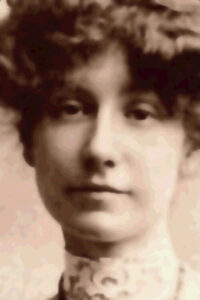
Black Magic A Tale of the Rise and Fall of Anti-Christ
In the large room of a house in a certain quiet city in Flanders, a man was gilding a devil.
The chamber looked onto the quadrangle around which the house was built; and the sun, just overhead, blazed on the vine leaves clinging to the brick and sent a reflected glow into the somber spaces of the room.
The devil, rudely cut out of wood, rested by his three tails and his curled-back horns against the wall, and the man sat before him on a low stool.
On the table in front of the open window stood a row of knights in fantastic armor, roughly modeled in clay; beside them was a pile of vellum sheets covered with drawings in brown and green.
By the door, a figure of St. Michael leaned against a chair, and round his feet were painted glasses of every color and form.
On the whitewashed wall hung a winged picture representing martyrdom; its vivid hues were the most brilliant thing in the room.
The man was dressed in brown; he had a long dark face and straight dull hair; from the roll of gold leaf on his knee he carefully and slowly gilded the devil.
The place was utterly silent, the perfect stillness enhanced by the dazzle of the blinding sun; presently the man rose and, crossing to the window, looked out.
He could see the sparse plants bordering the neglected grass-grown paths, the house opposite with its double row of empty windows, and the yellowing vine leaves climbing up the tiled roof that cut the polished blue of the August sky.
In between these windows, which were all closed and glittering in their golden squares, busts of old and weary philosophers were set; they peered out blindly into the unfathomable sunshine, and the dry tendrils of the vine curled across their leanness.
In the center square of grass was an ancient and broken fountain; some tall white daisies grew there, and the pure gold of their hearts was as bright as the gilding on the devil within. The silence and the blaze of the sun were one and indescribable.
The man at the window rested his elbows on the sill; it was so hot that he felt it burning through his sleeve; he had the air of one habitually alone, the unquestioning calm that comes of long silences; he was young and, in a quiet fashion, well-looking, wide in the brows and long in the jaw, with a smooth pale skin and cloudy dark eyes, his hair hung very straightly, his throat was full and beautiful.
In expression, he was reserved and somber; his lips, well-shaped but pale, were resolutely set, and there was a fine curve of strength to his prominent chin.
Read or download Book
Marjorie Bowen
Margaret Gabrielle Vere Long (1 November 1885 – 23 December 1952), who used the pseudonyms Marjorie Bowen, George R. Preedy, Joseph Shearing, Robert Paye, John Winch, and Margaret Campbell or Mrs. Vere Campbell, was a British author who wrote historical romances and supernatural horror stories, as well as works of popular history and biography.
Life
Bowen was born in 1885 on Hayling Island in Hampshire. Her alcoholic father Vere Douglas Campbell left the family when Bowen was young and was eventually found dead on a London street. She and her sister grew up in poverty, and their mother was reportedly unaffectionate. Bowen studied at the Slade School of Fine Art and later in Paris. At the age of 16, Bowen wrote her first work of fiction, a violent historical novel set in medieval Italy titled The Viper of Milan. The book was rejected by several publishers, who considered it inappropriate for a young woman to have written such a novel. It went on to become a best-seller when eventually published. After this, Bowen’s prolific writings were the chief financial support for her family.
She was married twice: first, from 1912 to 1916, to a Sicilian, Zefferino Emilio Constanza, who died of tuberculosis, and then to Arthur L. Long. Bowen had four children; a son and a daughter (who died in infancy) with Constanza, and two sons with Long. Her son with Long, Athelstan Charles Ethelwulf Long, was a colonial administrator.
In 1938, Bowen signed a petition organized by the National Peace Council, calling for an international peace conference to avert war in Europe.
In an interview for Twentieth Century Authors, she listed her hobbies as “painting, needlework, and reading”. Her cousin was the artist Nora Molly Campbell (1888–1971). Bowen died on 23 December 1952 at the St Charles Hospital in Kensington, London after suffering a serious concussion as a result of a fall in her bedroom.
Work
Bowen wrote over 150 books, with the majority being published under the pseudonym ‘Marjorie Bowen.’ She also wrote under the names Joseph Shearing, George R. Preedy, John Winch, Robert Paye, and Margaret Campbell. After publishing The Viper of Milan (1906), she produced a steady stream of writings until her death. Under her name, Bowen primarily published historical novels, including a trilogy about King William III: I Will Maintain (1910), Defender of the Faith (1911), and God and the King (1911). Her 1909 novel Black Magic is a Gothic horror novel about a medieval witch. Bowen also wrote non-fiction history books aimed at a popular readership.
Under the pseudonym “Joseph Shearing”, Bowen wrote several mystery novels inspired by real crimes. For instance, For Her to See (1947, a.k.a. So Evil My Love) is a fictionalized version of the Charles Bravo murder. The Shearing novels were especially popular in the United States, with Moss Rose, The Golden Violet, and Forget-Me-Not achieving both critical and commercial success, being championed by reviewers such as Phil Stong. Until the late 1940s, the identity of Shearing was not known to the general public, and some speculated it was the pseudonym of F. Tennyson Jesse.
Under the “George R. Preedy” pseudonym, Bowen wrote two non-supernatural horror novels, Dr. Chaos and The Devil Snar’d. Her last, posthumous, novel was The Man with the Scales (1954), about a man obsessed with revenge, and contains supernatural elements reminiscent of the works of E. T. A. Hoffmann. Many of these stories were published as Berkley Medallion Books. Several of her books were adapted as films.
Bowen’s supernatural short fiction was gathered in three collections: The Last Bouquet (1933), The Bishop of Hell, (1949) (featuring an introduction by Michael Sadleir), and the posthumous Kecksies, edited for Arkham House in the late 1940s, but not published until 1976.






